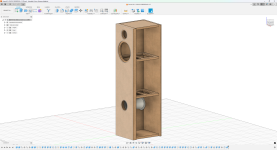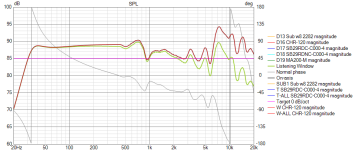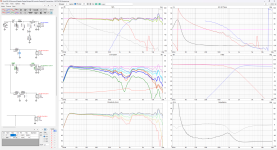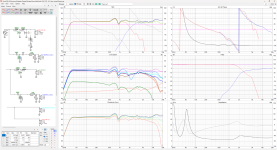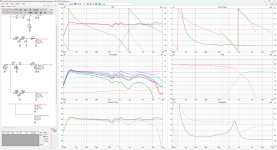Hello everyone,
I've been designing a tower speaker lately with the chr-120 and the sb acoustics sb29rdc-c000-4. The main reason why I'm pairing a tweeter to a fullrange is because the off axis response of the chr120 alone is not the best and I wanted to make a tower that would sound nice in a good range of positions in my room.
The design is a 60 L ported box, the vent is 18,3 cm long and 9 cm ID, made it so that turbolence is not a problem even at the highest volume the speaker can play.
I started the design by tracing the responses from the manufactures datasheet and modelled this crossover in the image (i attached also a zip with all the files). Since I don't have the speakers in my hand yet and am not prepared to make measurements I was wondering how far off this design would be from reality, especially considering the phases are calculated from vituixcad and in the woofer i set a z offset to match the impulse response calculated by vituix as well.
Since I'm a student and don't have much money to spend experimenting, am I fine designing a speaker this way and getting all the parts, rather than buying parts and changing them later?
I'm open to any kind of advice!
I've been designing a tower speaker lately with the chr-120 and the sb acoustics sb29rdc-c000-4. The main reason why I'm pairing a tweeter to a fullrange is because the off axis response of the chr120 alone is not the best and I wanted to make a tower that would sound nice in a good range of positions in my room.
The design is a 60 L ported box, the vent is 18,3 cm long and 9 cm ID, made it so that turbolence is not a problem even at the highest volume the speaker can play.
I started the design by tracing the responses from the manufactures datasheet and modelled this crossover in the image (i attached also a zip with all the files). Since I don't have the speakers in my hand yet and am not prepared to make measurements I was wondering how far off this design would be from reality, especially considering the phases are calculated from vituixcad and in the woofer i set a z offset to match the impulse response calculated by vituix as well.
Since I'm a student and don't have much money to spend experimenting, am I fine designing a speaker this way and getting all the parts, rather than buying parts and changing them later?
I'm open to any kind of advice!
Attachments
manuz74,
Since you are planning to use a tweeter, is there any particular reason why you have selected the MA CHR-120 (which is a wide band / full-range driver) as the mid-bass in your speaker?
Since you are planning to use a tweeter, is there any particular reason why you have selected the MA CHR-120 (which is a wide band / full-range driver) as the mid-bass in your speaker?
At first I wanted to see what the driver alone was capable of, but the problem was that the midrange was about 5 db recessed compared to the rest, reason why I opted for a tweeter. I know it's uncommon to use a fullrange as a woofer paired with a tweeter, but I liked how deep the bass could go with such a tiny driver and getting a +- 1,5 db on the full spectrum was very easy with the chr as a woofer. The distorsion is also very low with this model as far as I know. All considered, the chr 120 costs as much as any good midrange as well so I though why not?
I tried using other woofers as well, like the sb acoustics SB17CAC35-8, but somehow I couldn't get the phases to overlap in the xo region, maybe I could change tweeter or woofer if you have any suggestions
I tried using other woofers as well, like the sb acoustics SB17CAC35-8, but somehow I couldn't get the phases to overlap in the xo region, maybe I could change tweeter or woofer if you have any suggestions
Attachments
I wonder though if adding another driver with its separate acoustical center, the imaging and soundstage would suffer...
manuz74,
Have you already got the drivers or planning to get them?
With a 2-way speaker there are multiple things that will affect/impact the sound - the cross over is one of them, and also things like cabinet design and driver spacing. To get it right from scratch is not easy, especially for a beginner; there will be a lot measurements involved.
Have you already got the drivers or planning to get them?
With a 2-way speaker there are multiple things that will affect/impact the sound - the cross over is one of them, and also things like cabinet design and driver spacing. To get it right from scratch is not easy, especially for a beginner; there will be a lot measurements involved.
Hi there,
the great advantage of DIY is the variety of options
A )
if you take a look what the pro market offer there is this option
most near field studio monitors use a wave guide for the tweeter for time alignment, really good carpenters are able to integrate the the tweeter wave guide in the front baffle
active crossover is much easier to develop, but you still need a measurement system like as example (there are many others) CLIO pocket
with the FR as bass-mid-range driver you are able to play around much more with your active crossover crossover frequency to the tweeter let's say from low coupled tweeter with co fr 1500 Hz up to super tweeter with co fr 5000 Hz and above
german DIY magazine K+T offered a similar approach combining a 8 inch FR with a 2 inch FR with three different passive crossover approaches
B )
use a coax driver instead of the full range and the tweeter
for the best coax drivers you need to buy a used pair of KEF Q series boxes, many people throw the old Q series away since the new Q meta series is on the market
C )
build a large wave guide as front horn for the FR and couple it in a back loaded horn to reinforce the bass response and mount the tweeter on the FR front horn - tweeter in the front horn with coaxial mount position
here active crossover is mandatory since you need delay for the tweeter mounted in the front horn of the FR
this is the old approach (beside the tweeter as addition in front) like some very old Lowther FR cabinet design
this enclosure is a serious challenge to develop and build - for me this is an option for a long term project after retirement from work
hope it helps, Stefano
the great advantage of DIY is the variety of options
A )
if you take a look what the pro market offer there is this option
most near field studio monitors use a wave guide for the tweeter for time alignment, really good carpenters are able to integrate the the tweeter wave guide in the front baffle
active crossover is much easier to develop, but you still need a measurement system like as example (there are many others) CLIO pocket
with the FR as bass-mid-range driver you are able to play around much more with your active crossover crossover frequency to the tweeter let's say from low coupled tweeter with co fr 1500 Hz up to super tweeter with co fr 5000 Hz and above
german DIY magazine K+T offered a similar approach combining a 8 inch FR with a 2 inch FR with three different passive crossover approaches
- FAST / very low crossover 8 inch only sub woofer 2 inch as FR
- Studio / crossover between 1500 - 2000 Hz with bass mid-range 8 inch FR and cone tweeter 2 inch FR
- 8 inch FR + 2 inch FR as super tweeter / crossover above 5000 Hz
B )
use a coax driver instead of the full range and the tweeter
for the best coax drivers you need to buy a used pair of KEF Q series boxes, many people throw the old Q series away since the new Q meta series is on the market
C )
build a large wave guide as front horn for the FR and couple it in a back loaded horn to reinforce the bass response and mount the tweeter on the FR front horn - tweeter in the front horn with coaxial mount position
here active crossover is mandatory since you need delay for the tweeter mounted in the front horn of the FR
this is the old approach (beside the tweeter as addition in front) like some very old Lowther FR cabinet design
this enclosure is a serious challenge to develop and build - for me this is an option for a long term project after retirement from work
hope it helps, Stefano
Last edited:
30 Minutes correction time over
german DIY magazine K+T offered a similar approach combining a 8 inch FR with a 2 inch FR with three different passive crossover approaches
german DIY magazine K+T offered a similar approach combining a 8 inch FR with a 2 inch FR with three different passive crossover approaches
- FAST with 8 inch FR only as sub woofer and 2 inch FR as full range / very low crossover below 400 Hz
- Studio with bass mid-range 8 inch FR and cone tweeter 2 inch FR / crossover between 1500 - 2000 Hz
- 8 inch FR + 2 inch FR as super tweeter cone tweeter / crossover above 5000 Hz
I have a dac and omni mic for measurements that sometimes I use with my current speakers for eq with rew and equalizer apo, but I've only done in room measurements so far and never tried measuring raw responses from driver trying to keep away the room interaction, and i guess i would need that to get good measurements to start from am I right?manuz74,
Have you already got the drivers or planning to get them?
With a 2-way speaker there are multiple things that will affect/impact the sound - the cross over is one of them, and also things like cabinet design and driver spacing. To get it right from scratch is not easy, especially for a beginner; there will be a lot measurements involved.
Anyways I'd really like to use the chr 120 if I can, I've become quite obsessed with it and need to try it out now...
Last edited:
SBA_SLOB_GUY I'll further investigate the 2 inch FR as super tweeter and see what I can get out of it, any good reccomendation for such a driver? I know tang band made some small FR like that but never tried a design with them.
As for general guidelines, my question is if it's okay to design a speaker without having the drivers on hand, just by manufacturers datasheet and frequency responses, just to know if i need to buy 400 euro of stuff before realizing the speakers are not how the graphs told me...
As for general guidelines, my question is if it's okay to design a speaker without having the drivers on hand, just by manufacturers datasheet and frequency responses, just to know if i need to buy 400 euro of stuff before realizing the speakers are not how the graphs told me...
manuz74,
Short answer is that using the FR graphs in the manufacturer's data sheet will not give you the accurate results for your crossover; for your speaker, you will need to take measurements on the baffle that you have designed.
If you really want to try the CHR-120, then my suggestion would be that try it out as a wide band / full-range first.
If you want to explore tried and tested projects with other similarly sized drivers, here are two options:
https://sbacoustics.com/product/bromo/
Short answer is that using the FR graphs in the manufacturer's data sheet will not give you the accurate results for your crossover; for your speaker, you will need to take measurements on the baffle that you have designed.
If you really want to try the CHR-120, then my suggestion would be that try it out as a wide band / full-range first.
If you want to explore tried and tested projects with other similarly sized drivers, here are two options:
I built this pair of speakers for my brother’s workshop/garage. He has speakers on his workbench on either side of a PC monitor, and he is often standing at the bench as well as sitting. He needs the speakers to sound good in the nearfield, as well as being able to fill the garage with music.
His current speakers are the MTM version of the Paul Carmody Overnight Sensation. He likes these speakers, but when standing at the bench, he feels the tweeter is too low (it is basically aimed at his belly). I also believe that the MTM configuration might be aiming a null at his face when standing...
His current speakers are the MTM version of the Paul Carmody Overnight Sensation. He likes these speakers, but when standing at the bench, he feels the tweeter is too low (it is basically aimed at his belly). I also believe that the MTM configuration might be aiming a null at his face when standing...
https://sbacoustics.com/product/bromo/
Wait, I did not mention that in the crossover I did take into consideration the diffraction calculated in vituixcad with both drivers, and also the delay of the woofer from the tweeter caused by the difference in offset of the acoustical centers. I also merged the woofer files to the the woofer response in enclosure, in order to get the closest approximation for the chr-120 response in the modeled box.
Hi there,
here in Germany K + T guy Thomas Schmidt is using since decades the Visaton 2 inch FR chassis as decent cone tweeter - here the data sheet
https://www.visaton.de/en/products/drivers/fullrange-systems/frs-5-x-8-ohm
there are also some ideas available for a decent mounting option like this here

Hope it helps, Stefano
P.S.: if you want to sort out before hand what you can get out of this without buying the chassis (in this case very cheap although) Visaton offer a simulation software where you can play around with the Visaton chassis
https://www.visaton.de/en/literature-software/software
Boxsim has a far easier learning curve as Vituix CAD (only my personal opinion, i am a little bit too old for Vituix CAD), but Visaton want you to use their chassis and not other stuff, but there are ways to import measurements from other chassis
here in Germany K + T guy Thomas Schmidt is using since decades the Visaton 2 inch FR chassis as decent cone tweeter - here the data sheet
https://www.visaton.de/en/products/drivers/fullrange-systems/frs-5-x-8-ohm
there are also some ideas available for a decent mounting option like this here
Hope it helps, Stefano
P.S.: if you want to sort out before hand what you can get out of this without buying the chassis (in this case very cheap although) Visaton offer a simulation software where you can play around with the Visaton chassis
https://www.visaton.de/en/literature-software/software
Boxsim has a far easier learning curve as Vituix CAD (only my personal opinion, i am a little bit too old for Vituix CAD), but Visaton want you to use their chassis and not other stuff, but there are ways to import measurements from other chassis
Last edited:
Hi there,
here the first quick and dirty simulation with Boxsim using a very old 17cm Visaton FR chassis as a bass, active crossover 800 Hz Linkwitz-Riley 4th order, no active EQ at all



The BG17 is more for guitar speaker and need a very large bass reflex enclosure with still no bass below 80 Hz, but it has the right size for comparison
The whole stuff takes me 15 minutes, 10 minutes to get the screenshots posted here
Hope it helps, Stefano
here the first quick and dirty simulation with Boxsim using a very old 17cm Visaton FR chassis as a bass, active crossover 800 Hz Linkwitz-Riley 4th order, no active EQ at all
The BG17 is more for guitar speaker and need a very large bass reflex enclosure with still no bass below 80 Hz, but it has the right size for comparison
The whole stuff takes me 15 minutes, 10 minutes to get the screenshots posted here
Hope it helps, Stefano
Last edited:
I'll play with some visaton speakers and see what happens.
Vituixcad looks scary at the beginning but I've been making small projects for a couple years now and slowly learnt a lot of things so far. My issue is mostly related to financial matters, can't afford buying many speakers to play around since I'm still a student, but I enjoy very much designing speakers and wanted to build a nice tower for my room.
Thanks for the advice!
Vituixcad looks scary at the beginning but I've been making small projects for a couple years now and slowly learnt a lot of things so far. My issue is mostly related to financial matters, can't afford buying many speakers to play around since I'm still a student, but I enjoy very much designing speakers and wanted to build a nice tower for my room.
Thanks for the advice!
Hi there,
the good thing with the FRS5X is the price and it is available also in Italy
https://www.thomann.de/it/visaton_frs_5_x.htm
have fun!
- Stefano
the good thing with the FRS5X is the price and it is available also in Italy
https://www.thomann.de/it/visaton_frs_5_x.htm
have fun!
- Stefano
NMote that @Scottmoose has designed a number of WAW that use CHR-120 as bass driver.
If i was to approach this id want the tweeter to go down to 1 kHz … Decca London would be fantastic, but a modern dome or ribbon might reach that low ina waveguide or horn.
dave
If i was to approach this id want the tweeter to go down to 1 kHz … Decca London would be fantastic, but a modern dome or ribbon might reach that low ina waveguide or horn.
dave
Hello everyone,
I tried tweaking the first crossover I posted here some more but found it hard to get a response without dips in the woofer side. The main issue I'm having is phase alignment, somehow whatever driver I'm using I really find it hard to get both a linear response and phase alignment of the two drivers. In the attached image I was trying to align the phases of the sb acoustics sb17cac35-8 and the tang band w2-800sl (a 2 inch full range that should be able to cross low). Somehow I can't make these fit together, but this happens with almost any tweeter or small fullrange I try to blend with this woofer, and also happens with other woofers as well, which makes me wonder if I'm doing something wrong...
Hope anybody can help me understand why it's so hard to get phase alignment and good response altogether, thanks!
I tried tweaking the first crossover I posted here some more but found it hard to get a response without dips in the woofer side. The main issue I'm having is phase alignment, somehow whatever driver I'm using I really find it hard to get both a linear response and phase alignment of the two drivers. In the attached image I was trying to align the phases of the sb acoustics sb17cac35-8 and the tang band w2-800sl (a 2 inch full range that should be able to cross low). Somehow I can't make these fit together, but this happens with almost any tweeter or small fullrange I try to blend with this woofer, and also happens with other woofers as well, which makes me wonder if I'm doing something wrong...
Hope anybody can help me understand why it's so hard to get phase alignment and good response altogether, thanks!
Attachments
Eventually I understood that the sb29rdc blends generally more easily with a third order filter and the result is the first image attached. What bothers me is the hill happening from 500 to 900 hz followed by a 3 dp dip at 1000 hz. The rest, is linear enough for me and the phases overlap well in the xover region. Still I don't like the dip at 1khz, but that's chr fault.
I also modeled another tower, 40 L with the sb17cac35-8 and sb29rdc as well, the response look better to me and the phases overlap well too, so i might stick with this smaller design and try and see what happens. The main difference between the two designs is that the chr 120 can go louder than the sb17, 8 - 10 db louder in fact, but still the 95 db within the cone excursion of the sb17 would probably good for a small room like mine. Files are attached below if anyone's interested!
I also modeled another tower, 40 L with the sb17cac35-8 and sb29rdc as well, the response look better to me and the phases overlap well too, so i might stick with this smaller design and try and see what happens. The main difference between the two designs is that the chr 120 can go louder than the sb17, 8 - 10 db louder in fact, but still the 95 db within the cone excursion of the sb17 would probably good for a small room like mine. Files are attached below if anyone's interested!
Attachments
hi there,
i have always developed my speakers with an active crossover approach first trying to model a theoretical filter function for the acoustical filter resulting from speaker plus active crossover - in Visaton Boxsim there is an option to display the filter function in your simulated frequency response graph
you have to find out how much delay you need between the mid range and the tweeter if the time alignment is not done with the correct physical placement
this is as far as i understand the professional development approach for an active studio monitor right the reason why the wave guide for the tweeter is an integrated part of the whole speaker development
if you need to correct the time delay with a DSP crossover you will never achieve the same result as for the correct physical placement with the appropriate wave guide
active delay fits only for one measurement, either on axis or for a certain angle 5, 10, 15, 20 degree etc.etc.
i have seen how 1 mm in the difference in the point of sound origin can result in a completely different frequency response in the crossover region
for high crossover frequencies between a tweeter and a super tweeter in a horn speaker multi way design
so far - so good, Stefano
i have always developed my speakers with an active crossover approach first trying to model a theoretical filter function for the acoustical filter resulting from speaker plus active crossover - in Visaton Boxsim there is an option to display the filter function in your simulated frequency response graph
you have to find out how much delay you need between the mid range and the tweeter if the time alignment is not done with the correct physical placement
this is as far as i understand the professional development approach for an active studio monitor right the reason why the wave guide for the tweeter is an integrated part of the whole speaker development
if you need to correct the time delay with a DSP crossover you will never achieve the same result as for the correct physical placement with the appropriate wave guide
active delay fits only for one measurement, either on axis or for a certain angle 5, 10, 15, 20 degree etc.etc.
i have seen how 1 mm in the difference in the point of sound origin can result in a completely different frequency response in the crossover region
for high crossover frequencies between a tweeter and a super tweeter in a horn speaker multi way design
so far - so good, Stefano
Last edited:
Thank you Stefano,
I used the vituixcad impulse response tool to see without any filter applied the two calculated impulse responses of the woofer and tweeter and then applied a z offset to the woofer until the highest peak of the two overlaps. Sure it's not a measurement of the impulse response but I guess it should be pretty accurate, when I get the speakers I can take some measurements and then fix the crossover with real data. I'll keep you updated!
I used the vituixcad impulse response tool to see without any filter applied the two calculated impulse responses of the woofer and tweeter and then applied a z offset to the woofer until the highest peak of the two overlaps. Sure it's not a measurement of the impulse response but I guess it should be pretty accurate, when I get the speakers I can take some measurements and then fix the crossover with real data. I'll keep you updated!
- Home
- Loudspeakers
- Multi-Way
- Pairing Markaudio CHR-120 with a tweeter

